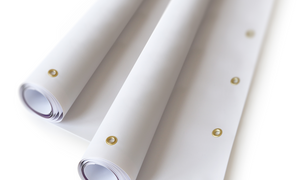7 Common Plastic Fabrication Methods and Which One is Right for You

Plastic fabrication is an integral part of numerous industries, from automotive to consumer electronics and food packaging to healthcare. With an array of plastic fabrication methods and tools available, selecting the right ones for your project can be daunting. Each method offers unique advantages and limitations, catering to specific requirements such as material properties, production volume, and cost.
Below, we explore some common plastic fabrication methods and information to help you make an informed decision.
What is Plastic Fabrication?
Plastic fabrication encompasses a diverse range of manufacturing processes used to shape raw plastic materials into finished products. It involves techniques such as injection molding, plastic extrusion, plastic welding, blow molding, thermoforming, compression molding, and rotational molding, each tailored to specific applications and production requirements.
Whether creating intricate components for electronics, durable packaging for consumer goods, or robust structural elements for automotive applications, plastic fabrication methods offer versatility, precision, and scalability. From prototyping to mass production, plastic fabrication plays a pivotal role across various industries, enabling users to create innovative products that enhance our daily lives.
>>Related read: 5 Plastic Fabrication Finishing Processes and How to Expertly Perform Them
Common Plastic Fabrication Methods and Their Applications
Common methods of plastic fabrication include the following:
1. Injection Molding
Injection molding is one of the most popular plastic fabrication methods due to its versatility. It involves high pressure injection of molten plastic into a mold cavity, where it cools and solidifies to form the desired shape. The essential parameters of the injection molding process are heat transfer and pressure flow. The machine mechanisms used for this process are known as a press (injection unit), and a mold which may also be referred to as a tool or sometimes a die.
It is also one of the most important processes for high volume production of small to medium sized thermoplastic parts and components. Most injection molding machines are designed so that they can be easily fitted with a variety of molds. Making this plastic fabrication method ideally suited for high-volume production runs with tight tolerances and complex geometries. There are typically four stages to this fabrication process.
- Clamping: A clamping mechanism is used to close both halves of a mold while the plastic polymer is injected into the mold.
- Injection: Thermoplastic pellets or granules are fed through a hopper or holding vessel into a heated barrel. The heated plastic is melted (plasticized) then injected into a mold with the use of a high-pressure hydraulic/mechanically driven plunger, plunger-plunger, screw plunger, or reciprocating screw type systems.
- Cooling: Once the molten plastic has been injected into the mold, the plastic begins to cool and harden. Cooling and hardening of the plastic can be achieved with the use of temperature-controlled cooling channels or pipes.
- Ejection: After the plastic has cooled and hardened, the mold is opened, and the newly formed part/component is pushed out of the mold.
2. Plastic Extrusion
Plastic extrusion is a continuous manufacturing process where plastic pellets are melted and forced through a die to create a continuous profile. It's commonly used for producing plastic sheets, pipes, tubes, and profiles with consistent cross-sections.
Extrusion offers high production rates and low tooling costs, making it suitable for large-scale production of linear products. It's widely employed in construction, packaging, and the food industry. The four common extrusion processes are tubing, blow-film, sheet film, and over-jacketing.
Tubing Extrusion: Tubing extrusion is a high-volume manufacturing process that uses heat and friction to melt plastic pellets (granules), into a continuous profile. The plastic then solidifies as it exits the extruder's die and is typically cooled with a water circulation system.
The tubing extrusion process creates thicker, denser, hollow plastics that can be cut to size and extruded to any length or desired diameter. This process is commonly used to produce piping and tubing for use in aircraft, automotive, construction, food/beverage, medical, and watercraft industries.
Blown-Film Extrusion: Similar to tubing extrusion, blown-film extrusion uses heat and friction to melt plastic pellets (granules), into a continuous tubular profile, which is then inflated by injecting it with air or another type of gas. A bubble is created, and the molten plastic then solidifies through an exterior air ring cooling system.
A set of collapsing frames or guides are then used to collapse the bubble into two or more defined layers. A series of nip rollers flatten the layers together to form a two-layered plastic film that is then wound onto a cylindrical roll for packaging purposes. Applications typically include laminating film, shrink film, agricultural covering film (greenhouse), bags, and clothing.
Sheet & Film Extrusion: Like blown-film extrusion, sheet and film extrusion performs a compression process that uses a die to create flat plastic sheets or films. Sheet & film extrusion utilizes heat and friction to melt plastic pellets (granules), which are moved or conveyed to a flat sheet die. The extrudate is pulled through a series of cooling (chill) rollers to cool and regulate the sheet thickness.
The extrudate is transported through a precise roller system to a slitting station to be cut and is then uniformly rolled at a winding station. These sheets are typically used to wrap trays for produce and meats, as well as freshness/safety seals for butter, margarine, yogurt, etc.
Over-Jacketing Extrusion: Over-jacketing, also referred to as over-coating extrusion, uses heat and friction to melt plastic pellets (granules), which applies a continuous outer layer of plastic onto an existing wire or cable. There are two different types of die tooling used for coating over a wire, tubing (or jacketing) and pressure. In jacketing tooling, the melted polymer does not touch the inner wire until immediately before the die lips. In pressure tooling, the melted polymer contacts the inner wire long before it reaches the die lips. This is done at a high pressure to ensure good adhesion of the melted polymer.
If adhesion is required between the new layer and existing wire, pressure tooling is used. If adhesion is not desired or necessary, then jacketing tooling is used instead. This process is typically used to encapsulate or insulate copper, silver plated copper, nickel titanium, precious metals (gold, silver, etc.), as well as a range of polymer-based fibers, such as Kevlar and Vectran.
3. Plastic Welding
Plastic welding is a joining process that involves melting and fusing two or more pieces of thermoplastic material together to form a strong bond. Unlike extrusion, which shapes plastic material into a new form, welding joins existing pieces of plastic to create a single, unified structure.
Various welding techniques are used depending on the application, including hot gas welding, ultrasonic welding, vibration welding, and friction welding. Plastic welding is commonly used in industries such as automotive, construction, and fabrication for joining components, repairing plastic parts, and sealing seams. The four most common processes for plastic fabrication applications are hot air (gas) welding, ultrasonic welding, spin welding and solvent welding.
- Hot Air Welding: Hot air welding, also known as hot gas welding, is a widely used method for thermoplastics. It involves heating the plastic surfaces with a specialized extrusion welding machine until they reach their melting point. The melted surfaces are then pressed together, which creates a strong bond as they cool.
- Ultrasonic Welding: Ultrasonic welding is an economical and easily automated welding technique in which high-frequency energy generates heat and welds plastic parts together with a specialized welding machine. This method is often used for joining small or delicate plastic components, such as electrical parts, or toys. It is also widely used in the manufacture of appliances, automotive, and medical device components, as well as a variety of enclosed assemblies and subassemblies.
- Spin Welding: Spin welding is frequently used for circular or cylindrical plastic parts, such as pipes, fittings, or containers. In this technique, one part is held stationary while the other is rotated at a high speed. Frictional heat is generated between the two parts, and the plastic softens and forms a bond as a result.
- Solvent Welding: Solvent welding is a bonding method that uses a chemical solvent to soften and fuse plastic parts together. The solvent is applied to the joint area, causing the plastic to dissolve and form a bond as it evaporates. Solvent welding requires compatible plastics and careful application of the solvent.
>>Related read: How to Execute the 4 Most Common Types of Plastic Welds
4. Blow Molding
The blow molding fabrication process is used to form hollow plastic parts, such as bottles, containers, and automotive ductwork. There are three types of thermoplastic blow molding methods. These are extrusion blow molding, injection blow molding, and stretch blow molding processes.
- Extrusion Blow Molding: Extrusion blow molding is a process that involves melting plastic and then extruding it into a hollow tube called a parison. The parison is then placed into a mold, which closes around it, and air is blown into the parison to inflate it against the mold walls. When the plastic cools, it solidifies and takes the shape of the mold, and the part is ejected. The excess material which can form around the outside edges of the molded part is then removed using a deflashing
- Injection Blow Molding: Like injection molding, molten plastic is injected into a mold cavity. Once the molten plastic has been injected into the mold, the preformed hot material is then transferred or indexed to a blow molding station where it is blown into the desired shape and size. The injection molding process allows for more precise detail such a pipe threads.
- Stretch Blow Molding: Like injection molding, molten plastic is injected into a mold cavity. Once the molten plastic has been injected into the mold, the hot material is transferred or indexed to a blow molding station where a stretch rod stretches the preformed material to the desired length, while air is blown into the preformed hot material to the desired form shape and size.
Blow molding offers excellent design flexibility, allowing for complex shapes and intricate details. It's well-suited for producing lightweight, durable, and cost-effective containers in large volumes.
5. Thermoforming
Thermoforming involves heating a plastic sheet until pliable and then forming it over a mold using vacuum, pressure, or mechanical force. Thermoforming offers fast cycle times, low tooling costs, and the ability to produce large parts with minimal material waste. It's an ideal choice for prototyping and medium- to high-volume production of shallow plastic parts. There are common process methods of thermoforming. They are thin gauge and heavy (thick) gauge thermoforming.
Thin Gauge: Also known as continuous thin gauge sheet forming, is the most common method of thermoforming for high volume plastic fabrication applications. A plastic sheet is fed from a roll or from an extruder for transport through an oven and heated to the specified forming temperature. The heated sheet then indexes into a form station, where a mating mold and pressure-box close on the top face and bottom face of the plastic sheet.
A vacuum (negative pressure) is then applied to remove trapped air, while pulling the heated material into and/or onto the mold. Pressurized air (positive pressure) is also applied so that the heated material will be formed to the shape of the mold. After the short form cycle, a burst of reverse (positive) air pressure is applied from the vacuum (negative) side of the mold as the form opens, and the part is then ejected from the mold.
Heavy Gauge: Heavy (thick) gauge forming utilizes the same basic plastic fabrication process as continuous thin-gauge sheet forming. Many heavy gauge forming applications use vacuum only in the form process. However, some processes do require the use of both air pressure (positive) and vacuum (negative) to help form the part.
Thin gauge roll-fed or inline extruded thermoforming applications are used for rigid or semi-rigid disposable packaging (Meat trays, ice cream tubs, sandwich packs, etc.), while heavy or thick gauge cut sheet thermoforming applications are primarily used as permanent structural components (Aircraft and automotive interiors, protective cases, hospital bed components, etc.)
6. Compression Molding
Compression molding is a plastic fabrication method that is commonly used in polymer manufacturing processes for thermosets and thermoplastics, as well as elastomers and natural rubbers. A measured amount of preheated material is usually referred to as a charge. The charge is placed into a heated mold cavity and is compressed under high pressure until it conforms to the shape of the mold.
When considering compression molding for your application, note that compression molding typically has lower tooling costs, and is better suited for low- to medium-volume production runs. Compression molding was developed for synthetic materials and is the least expensive molding method for thermosetting plastics. They possess high strength and durability, are temperature resistant, and have good surface quality. Parts can be produced in an array of lengths, thicknesses, and complex geometries. When additives are used in the process, parts can be fabricated so that they are anti-corrosive and/or electrically insulative as well. Overall, compression molding fabrication has a better per-part cost versus alternative fabrication processes, and is commonly used for producing large, complex parts such as automotive components, electrical enclosures, and appliance parts.
7. Rotational Molding
Rotational molding, also known as rotomolding, is a method for producing large, hollow plastic parts such as tanks, containers, and playground equipment. It involves heating and rotating a mold filled with powdered plastic resin until the resin coats the inner surface and forms the desired shape.
It is a three-stage process that uses molds on a rotating frame, a heating chamber, and a cooling chamber. The molds for the rotomolding fabrication process are specially designed and can produce single wall and double walled products. The plastic material most used for this process is polyethylene. To begin the process, polyethylene resins are loaded into a mold, and the mold is rotated as it is heated. The frame of the mold can rotate the mold to every point of its rotational axis. As the mold rotates, the resin is spread over the interior surface of the mold giving the finished product an equal and even thickness across the mold surface.
After a predetermined time, the mold moves from the heating chamber to the cooling chamber, where the melted resins are allowed to cool before the plastic product is ejected from the mold. Since rotational molding is a non-pressure molding process, the molds do not have to be produced to withstand high pressures like other types of molding fabrication processes. Therefore, lower pressure molds are very cost effective and offer design flexibility, excellent durability, and uniform wall thickness. It's well-suited for producing large, one-piece parts with complex geometries.
How to Choose Your Plastic Fabrication Method
When selecting the right plastic fabrication method for your project, consider the following factors:
- Production Volume: Determine the expected production volume, as some methods are more cost-effective for large-scale production runs, while others are better suited for low to medium-volume production.
- Part Complexity: Consider the complexity of your part's design, including features, geometries, and tolerances. Choose a method that can accommodate your design requirements effectively.
- Material Properties: Evaluate the mechanical, thermal, and chemical properties required for your application. Select a compatible plastic material and fabrication method that can meet your performance criteria.
- Cost and Lead Time: Assess the initial tooling costs, production costs, and lead times associated with each fabrication method. Balance your budget constraints with project timelines to optimize cost-effectiveness.
Consider creating a checklist to better evaluate your needs and standardize your method selection process.
Top 5 Tools for Your Plastic Fabrication Applications
To achieve your weld, you’ll need high-performance tools suited for your chosen plastic fabrication method. Several of these include:
- Industrial Extrusion Welder: A hot air tool, such as the HSK-IE25 or HSK-IE60 is a high volume stationary extruder system that generates a stream of hot air and are used in plastic fabrication for welding, thermoplastic materials.
- Handheld Extrusion Welder: An extrusion welder, like the Drader Injectiweld or Munsch MAX-32-D, is a specialized tool for joining thermoplastic materials by melting them and extruding molten filler material into the joint, creating a strong and durable bond in applications like tank fabrication and pipe welding.
- Welding Shoes: Welding shoes are interchangeable extrusion welder components that come in various shapes and sizes to match the specific welding requirements of different materials and joint geometries.
- Ultrasonic Welding Machine: The Sonics X-Press XPE or XPT Ultrasonic Welding Machine is a solid-state welding process that produces a weld by local application of high-frequency vibratory energy while the work pieces are held together under pressure.
- Ultrasonic Handheld Welding Machine: The Sonics H520/CV55 is a solid-state benchtop welding process that produces a weld by local application of high-frequency vibratory energy while the work pieces are held together under pressure.
Each of these hot air tools serves specific purposes in plastic fabrication, offering precise control over temperature, airflow, and heating profiles to ensure optimal results in various applications.
Elevate Your Productivity with the Right Plastic Fabrication Tool
Selecting the right plastic fabrication method is crucial for achieving desired outcomes in terms of quality, cost, and time-to-market. By understanding the capabilities and limitations of common fabrication methods and considering key factors such as tools, production volume, part complexity, material properties, and cost, you can make an informed decision that aligns with your project requirements and objectives.
If you need help determining any of these factors or with selecting a tool, contact our team. We would be happy to help.

- Robert Heater






